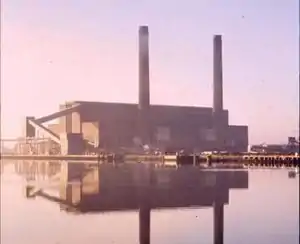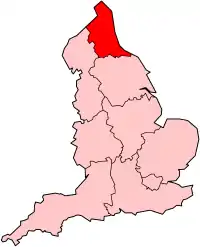| North Tees A, B & C Power Stations | |
|---|---|
 North Tees C Power Station in the 1980s | |
| Country | England |
| Location | Billingham |
| Coordinates | 54°35′13″N 1°15′47″W / 54.587°N 1.263°W |
| Status | Decommissioned and demolished |
| Construction began | 1921 |
| Commission date | 1921 |
| Decommission date | 1983 |
| Operator(s) | North Eastern Electric Supply Company (1921–1948) British Electricity Authority (1949–1955) Central Electricity Authority (1955–1957) Central Electricity Generating Board (1957–1971) Imperial Chemical Industries (1971–1983) |
| Thermal power station | |
| Primary fuel | Coal |
| Power generation | |
| Units operational | A station: Two Metropolitan-Vickers 20 MW B station: Two Parsons and one Metropolitan Vickers C station: Two 60 MW |
| Nameplate capacity | 1921: 40 MW 1983: 263 MW |
grid reference NZ477210 | |
North Tees Power Station refers to a series of three coal-fired power stations on the River Tees at Billingham in County Durham. Overall, they operated from 1921 until 1983, and the C station, the last on the site, was demolished in 1987. Billingham Biomass Power Station is to be built on their site.
North Tees A
History
In 1917, the Newcastle upon Tyne Electric Supply Company (NESCo) took control of the principal electrical undertakings for a large area in south County Durham and North Yorkshire. To supply the newly acquired area, NESCo built the North Tees Power Station on the banks of the River Tees at Billingham.[1] The construction of the station began in 1917 and was completed for opening in 1921.[2]
Design and specification
The station was designed by the engineering consultants Merz & McLellan. The station used two Metropolitan-Vickers 20,000 kilowatt (kW) turbo-alternators to generate electricity, giving it a total generating capacity of 40,000 kW.[3] The Babcock & Wilcox boilers which were used to provide the steam to the turbines in the station, were famous in engineering circles at the time. In 1918 the boilers became the first in the world to use steam at up to 450 psi, and pioneered the practice of reheating it during expansion in the turbine plant.[4][5] This development resulted in a further increase in the efficiency of power generation, and an appreciable decrease in the quantity of coal consumed per unit of electricity generated.[1] In 1922, W.S. Monroe of the Chicago-based consulting firm Sargent & Lundy described North Tees Power Station as "the most advanced power station in the world".[3]
The station was connected by NESCo's high voltage transmission lines to their power stations on the River Tyne, for successful running "in parallel".[1] When the UK's national grid distribution system was brought into use in 1932, the station was one of a small number of stations in the region to be converted from the 40 hertz (Hz) frequency used by the North Eastern grid system to the 50 Hz frequency used by the national system.[6] However, the nearby ICI plant, which operated its own power station, required the North Tees A station's power as back-up, but the power needed to be supplied at 40 Hz, and so the A station retained three frequency changers to supply back-up power for many years after the change over, until the 1950s, when new electrical equipment needed to be ordered at the ICI plant.[7]
Closure
The A station closed in 1959, after a number of years being used as a reserve station for high demand. Following closure, Metropolitan-Vickers took the rotors from the stations and tested them to destruction, to find out why the older machines were more efficient than the new ones.[7]
North Tees B
The B station was commissioned in 1934, and used pulverised fuel firing, an advanced technology at the time the station was built. The station generated electricity using two Parsons and one Metropolitan-Vickers turbines, each driving two alternators in tandem. It was demolished in the late 1960s.[7]
Upon nationalisation of the British electricity supply industry in 1948 the ownership of North Tees A and B power stations were vested in the British Electricity Authority, and subsequently the Central Electricity Authority and the Central Electricity Generating Board (CEGB). The electricity distribution and sales functions were vested in the North Eastern Electricity Board.[8]
The electricity output from the A and B stations was:[9][10]
| Year | Station output GWh |
|---|---|
| 1953/4 | 174.2 |
| 1954/5 | 239.6 |
| 1955/6 | 191.3 |
| 1956/7 | 120.9 |
| 1957/8 | 76.6 |
| North Tees B | |
| 1960/1 | 31.113 |
| 1961/2 | 25.0 |
| 1962/3 | 45.22 |
| 1966/7 | 48.786 |
North Tees C
History
North Tees C Station was proposed in 1945, by the original two stations' operators, NESCo. However, the scheme was taken over by the British Electricity Authority when NESCo was nationalised in 1948.[1][11] The station was built by the Cleveland Bridge Company and completed in 1949.[12]
Design and specification
The C station had four Parsons 60,000 kilowatt (kW) turbo-alternators with steam raised in seven Babcock and Wilcock boilers fed via a steam range , giving it a total generating capacity of 240 MW.[11][1] The station's exterior was designed by Giles Gilbert Scott, who also designed Battersea Power Station.[13] The station was one of the first in the world to use hydrogen cooled generators.[7] It was also the first in England to use 66,000 V air blast switchgear.[1]
The boilers had an output capacity of 2,520,000 pounds per hour (317.5 kg/s) of steam at 900 psi (62.1 bar) and 496 °C. In 1971 the station delivered 1,097.33 GWh of electricity.[14]
The electricity output from the C station was:[9][14][10]
| Year | Station output GWh |
|---|---|
| 1953/4 | 1097.7 |
| 1954/5 | 1171.7 |
| 1955/6 | 1089.3 |
| 1956/7 | 1055.7 |
| 1957/8 | 1128.6 |
| 1960/1 | 1445.45 |
| 1961/2 | 1338.6 |
| 1962/3 | 1275.6 |
| 1966/7 | 1110.1 |
| 1971/2 | 1097.3 |
| 1978/9 | 378.0 |
Closure
The station was operated by the CEGB (north east region), The station was decommissioned on 31 October 1983, with a generating capacity of 236 MW.[15] In 1987, the site was acquired by Able UK and the station demolished so they could redevelop the site as Billingham Reach Industrial Estate.[13][16]
Future of site
The station's site is currently part of Billingham Reach Industrial Estate, an international wharf owned by Able UK Ltd.[13] On 15 October 2009, planning permission was granted for the Billingham Biomass Power Station, which is to be built on the site of the former coal-fired power stations.[17] As at October 2017 the old power station site remains undeveloped.
References
- 1 2 3 4 5 6 North-Eastern Electric Supply Company Limited 1889–1948. Newcastle upon Tyne: T.M Grierson Ltd. March 1948.
- ↑ "North Eastern Electricity Board". The National Archives. Retrieved 5 November 2008.
- 1 2 Parke Hughes, Thomas (1993). Networks of Power. JHU Press. pp. 457–458. ISBN 0-8018-4614-5. Retrieved 8 February 2009.
- ↑ Dummelow, John. "Metropolitan-Vickers Electrical Co 1899–1949 by John Dummelow: 1909–1919". gracesguide.com. Retrieved 23 December 2010.
- ↑ Parsons, R.H. (1939). "X". The Early Days of the Power Station Industry. Cambridge: Cambridge University Press. p. 183.
- ↑ Pears, Brian (23 February 2003). "Norfolk to Northumberland". Rootsweb. Archived from the original on 15 July 2011. Retrieved 9 September 2009.
- 1 2 3 4 Bate, David. "North Tees Power Station, Billingham Reach. 1967\r". Picture Stockton. Archived from the original (ASPX) on 8 October 2011. Retrieved 23 December 2010.
- ↑ Electricity Council (1987). Electricity Supply in the United Kingdom: a Chronology. London: Electricity Council. p. 60. ISBN 085188105X.
- 1 2 Garrett, Frederick C., ed. (1959). Garke's Manual of Electricity Supply vol.56. London: Electrical Press. pp. A-80–81, A-129.
- 1 2 CEGB Annual report and Accounts, 1961, 1962 & 1963
- 1 2 "ELECTRICITY (NORTH-EASTERN AREA)". Mr Shinwell. 31 October 1945. Retrieved 5 November 2008.
- ↑ "A – Z list of Bridges Built by Cleveland Bridge Company". Newcastle University. Archived from the original on 27 May 2003. Retrieved 18 April 2011.
- 1 2 3 kjfitz (15 April 2007). "Former ICI Bellingham explosives plant and nuclear power plant". virtualglobetrotting.com. Retrieved 20 November 2008.
- 1 2 CEGB (1972). CEGB Statistical Yearbook 1972. London: CEGB. p. 15.
- ↑ Shaw, Giles (16 January 1984). "Coal-fired Power Stations". Parliamentary Debates (Hansard). Retrieved 22 July 2009.
- ↑ Historic England. "NORTH TEES POWER STATION (602510)". Research records (formerly PastScape). Retrieved 7 October 2013.
- ↑ "£200 million biomass plant wins planning approval". New Energy Focus. 16 October 2009. Retrieved 23 December 2010.
